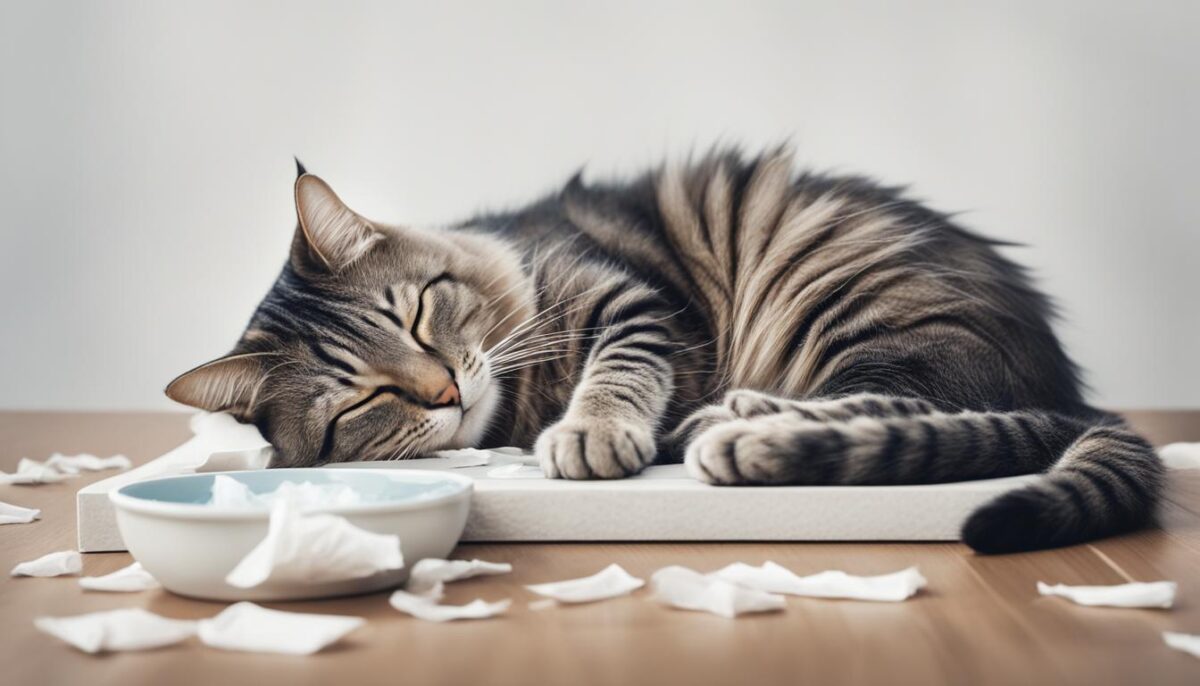Hey there! Did you know that your furry friend can get a fever just like you do? Yes, cats can feel under the weather when their body fights off nasty germs. A fever in a cat means their body is a bit hotter than usual – over 102.5º F, to be exact. But don’t try to guess by touching their nose; it won’t work. You need a special tool called a thermometer to really tell. And remember, if their fever jumps way up, over 106º F, it’s time to call the vet fast to make sure your kitty gets the care it needs.
Key Takeaways
- Cats can get fevers, too, when fighting germs.
- A cat’s fever is too high if it’s over 102.5º F.
- Checking their temperature needs a thermometer, not just by feeling their nose.
- High fevers are bad news, call your vet if it’s over 106º F.
- Pet care means keeping an eye out for fever signs in your cat.
What Is a Fever in Cats?
When your kitty’s body gets warmer than usual, it might mean they have a fever. Your cat’s normal body heat should be between 100.4º and 102.5º Fahrenheit. If it’s higher than that, it’s called a fever or hyperthermia. Fever in cats can be a way for them to fight off sicknesses, kind of like how your body gets hot when you’re not feeling well.
Sometimes, a fever can start because of different things such as infections or little injuries, we call “boo-boos”. When your cat’s temperature stays up for days and you don’t know what’s causing it, we call this a fever of unknown origin or FUO.
Here’s a table about what temperatures mean for your cat:
| Temperature (Fahrenheit) | What It Might Mean |
|---|---|
| 100.4º – 102.5º | Normal and cozy |
| 102.6º – 104.0º | Starting to be a fever |
| 104.1º – 106.0º | High fever, time to worry |
| Above 106.0º | Danger zone, call the vet! |
Remember, when your cat’s fever gets too high, it’s not good for them and you need to call your vet. That’s the animal doctor who knows just what to do!
It’s cool to know these things, right? That way, you can help your cat stay happy and healthy!
Can Cats Get Fevers: Verifying Your Feline’s Temperature
If you’re wondering about checking your cat’s temperature, it’s something you can do at home. Think of it like a cat health check-up. We’ll first get everything ready, then check your cat’s temperature step by step. Not too hard, right? If your kitty does have a fever, I’ll also tell you when it’s time to call the vet.
Preparing to Take Your Cat’s Temperature
Start by getting a feline thermometer. Give your kitty a yummy treat to make it less scary for them. Hold your furry friend gently, lift their tail, and be ready to be super gentle. It might seem a little weird, but it’s important to know how they’re feeling inside.
Step-by-Step Guide to Safely Check the Temp
Now, with your cat close and calm, it’s time to use the thermometer. Here’s what you do:
- Hold your cat snugly to keep them still.
- Lift their tail up high.
- Gently put the thermometer in your cat’s back end just a little bit. Be extra careful to not hurt them.
- Wait for the beep to know you’re done.
- Take out the thermometer and clean it with rubbing alcohol.
If your thermometer shows a number higher than 102.5º F, that might mean your cat has a fever.
Knowing When to Consult Your Vet
If that number on the thermometer is big and stays there for more than a day, it’s time to chat with your vet. They know lots about cat health and can help your kitty feel better. Remember, a vet is a cat’s best friend when they’re not feeling so great.
When it comes to your pet’s health, you’re the best person to help them when they can’t tell you they don’t feel well. With a little love and the right tools like a good thermometer, you’re all set to make sure they’re healthy and happy. So, go ahead and be a super pet parent today!
Recognizing the Symptoms of a Fever in Your Cat
Does your cat seem a bit off? It might be sick. Sometimes, cats act differently when they have a fever. If you know what to look for, you can help your furry friend feel better sooner.
Behavioral Signs of a Feverish Feline
Watch how your cat acts. A sick cat may not want to eat or play. It might just want to sleep or it may hide from people. If your cat doesn’t lick its coat as much as usual, that’s another hint it might not feel well. These changes in cat behavior are important to notice. They help you understand when your cat has a fever or is not feeling well.
Physical Signs That Indicate Fever in Cats
Cats can’t tell us when they’re not feeling good. But their bodies show signs. Your cat may be hot to touch or shake as if cold. It might breathe really fast or cough. If you see any of these symptoms of fever in cats, be sure to keep a close eye on them. These little signs can mean your cat needs help.
- Eating less or not at all
- Seeming sad or lacking energy
- Hiding in quiet places
- Shaking or quick breathing
- Coat not as clean as usual
Remember, it’s always good to call your vet if you think something is wrong. They know how to make cats feel better!
Common Causes Behind Your Cat’s Fever
Does your cat feel warmer than usual? They might have a fever. Fever in cats can happen for many reasons. Some reasons for cat fever are infections in cats like colds, flu, or something worse. If your cat has a small cut and it gets dirty, they could get an infection that leads to a fever. It’s their body’s way of fighting off the bad germs.
Sometimes, your kitty might get sick from inside their body. Feline illnesses like tumors or big words like lupus can make their temperature go up. Medicine that helps with one problem might give them a fever as a side effect, too.
Have you seen your cat chewing on plants or eating something they found outside? They could eat something bad that gives them a fever. Or they might get bit by a bug like a tick that makes them sick.
Let’s look at different things that can make cats hot:
- Germs: Tiny bugs you can’t see. They can be in the air, in water, or on other animals.
- Getting hurt: Even a small ouch can lead to fever if germs get inside.
- Medicines: Pills that help them can sometimes cause fevers.
- Going outside: Cats who play outside might find more germs.
- Other sick animals: If a friend is sick, they could pass it to your cat.
When cats get one of these problems, their bodies get busy trying to make them better, and a fever can start. It’s important to know what’s making your cat not feel well, so you can help them.
If you think your furry buddy has a fever, you can look for signs like them being sleepy, not wanting to play, and not eating much. And if they are very hot, or the fever lasts a long time, a trip to the vet is a good idea. The vet is like a doctor for animals—they can find out the cause of the fever and help your cat feel comfy again.
How to Care for a Cat with a Fever
When your furry friend is feeling under the weather, it’s crucial to know the steps to take to ensure they get better. Caring for a sick cat involves more than just love; it requires attention to detail and the right approach to feline fever treatment. Let’s find out how you can help your cat find comfort and health during this tough time.
Ensuring Proper Hydration and Comfort
One of the first things to do is make sure they stay hydrated. Just like people, cats need plenty of water when they have a fever. A sick cat might not want to drink, so you need to encourage them gently. You can also make their bed soft and cozy so they can rest and fight off whatever is making them sick.
Understanding the Dangers of Human Medications
Remember, what’s good for us might be bad for our pets. Never give your cat medicine meant for people—it could make them very sick. If your cat’s fever doesn’t go down after a day or it’s very high, it’s time to call your vet. They’ll know how to help, whether it’s special medicine or extra ways to get liquids into your kitty.
Pet hydration and comfort are key when caring for a sick cat. With a little help and a lot of love, your cat should be back on their paws in no time. But if things don’t get better, don’t wait—feline fever treatment given by a vet is the best way to help your friend heal.
Complications and Risks of High Fever in Cats
When your fluffy friend has a fever, you might worry a lot. A fever can be a sign that your cat’s body is fighting a germ or healing a boo-boo. But, if the fever gets too high, like over 106º F, it can be bad news. This is when you need to act fast because your cat’s health is in danger. That’s a cat high fever risk you can’t ignore.
High fever may lead to problems within your cat’s body. Maybe you notice they’re not playful anymore or don’t want to cuddle. A cat with a high fever might need special medicine, and the vet can help with that. The vet knows lots about fever-related complications and can give the care your cat needs, so they can get their purr back.
If the fever is really high, it can become a feline health emergency. The vet might even need to give your cat water in their veins, called fluids. This helps them not get dehydrated and feel better quicker.
| Temperature | Risks | What You Can Do |
|---|---|---|
| 102.5 – 104.9º F | Watch your cat closely. | Make sure they drink water and rest. |
| 105 – 106º F | Your cat might feel really sick. | Call the vet for advice quickly. |
| Above 106º F | It’s an emergency! | Take your cat to the vet right away. |
Remember, when your cat’s fever is too high, you shouldn’t wait to see if they’ll get better on their own. Always check with your vet. Because you love your furry buddy, and you want them to be around for a long time, playing and being happy!
The Risk Factors: Outdoor Versus Indoor Cats
When it comes to your purring pals, where they spend their time can really change their chances of staying well. Cats that hang out outside run into more things that could make them sick. But even if your cat hangs out inside, they still need to be looked after to keep them from getting sick.
Outdoor Exposures that Could Lead to Fevers
Outdoor cats love to explore, but sometimes they meet bugs or animals that carry germs. Cats can get tiny bites or even fleas from these critters, which can make them feel bad. These outdoor cat health risks can lead to fevers which tell you they’re fighting off these uninvited germs.
Protecting Indoor Cats from Infectious Diseases
Even if your kitty doesn’t go outside, they still need your help to stay safe. Keeping your home clean and keeping away from sick animals can help. Also, bringing them to the vet can keep them away from nasty sicknesses. Here’s a quick guide on preventing cat sickness, for both outdoor and indoor cats:
| Outdoor Cats | Indoor Cats |
|---|---|
| Check for fleas and ticks regularly | Keep a clean, clutter-free home |
| Visit the vet for check-ups and shots | Avoid contact with outdoor animals |
| Provide fresh water and food daily | Play and exercise to keep them happy |
| Watch for changes in behavior or appetite | Get them check-ups and shots, just like outdoor cats |
By understanding the risks and taking small steps every day, you can make a big difference in keeping your furry friend healthy and happy!
Conclusion
Knowing about your cat’s health is really important. You’ve learned that cats can get fevers just like people do, and it’s your job to be aware of the signs. Fevers can be a bit tricky because cats can’t tell us when they’re feeling hot. So it’s up to you to check with a thermometer to be sure. And looking after a sick kitty isn’t just about making sure they’re warm and cozy; it’s also about being smart and safe when they’re not well.
You now know that if your fluffy friend isn’t acting like themselves and you think they might have a fever, it’s best to use a thermometer to check. Always make sure they have water to drink and a quiet place to sleep. This is being really good at responsible pet care. If your kitty is sick for more than a day, or if you feel really worried about them, it’s time to take a trip to the vet. They know just what to do to help your cat start feeling like their playful, happy self again.
Remember, keeping an eye out for any changes can help avoid big problems. Let’s keep our furry pals healthy and ready for fun—with your care and these handy cat health tips, your buddy will always have a chance to feel better. Stay aware of feline fever, so you can make sure your cat stays fit and active!
FAQ
Can cats really get fevers like humans do?
Yes, cats can indeed get fevers, which is an increase in body temperature usually indicating an underlying medical condition or immune response.
What is a normal body temperature for a cat?
A normal body temperature for a cat ranges between 100.4º and 102.5º Fahrenheit.
How can I tell if my cat has a fever?
You can’t determine a fever by feeling your cat’s nose or body. You need to use a digital thermometer to check their temperature rectally for an accurate reading.
What should I do if my cat’s temperature is above the normal range?
If your cat’s temperature is above 102.5º F, it’s best to contact your veterinarian as it could be a sign of illness or infection.
What are some behavioral changes that may indicate my cat has a fever?
Behavioral changes such as lethargy, decreased appetite, hiding, less grooming, or changes in drinking habits can be signs that your cat may have a fever.
What causes fevers in cats?
Fevers in cats can be caused by infections, inflammation, injuries, certain medications, and some diseases such as cancer or autoimmune disorders.
How should I care for my cat if they have a fever?
Ensure your cat has access to plenty of fresh water, a comfortable place to rest, and avoid giving any human medication. Consult with your vet for the appropriate treatment plan.
What risks are associated with a high fever in cats?
Very high fevers, especially those exceeding 106º F, can lead to serious complications and damage to internal organs, and require immediate veterinary attention.
Are outdoor cats at greater risk for getting fevers?
Yes, outdoor cats are more exposed to factors that can cause fevers, such as infections from other animals, parasites, and environmental hazards.
How can I reduce the risk of my indoor cat getting a fever?
You can reduce the risk by keeping your indoor cat away from sick pets, maintaining regular vaccinations, and ensuring a clean and safe living environment.


